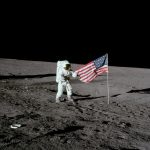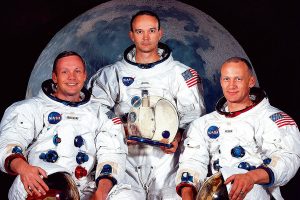 Most people know that at 10:56pm EDT, on July 20, 1969, American astronaut Neil Armstrong, 240,000 miles from Earth, speaks these words to more than a billion people listening at home, “That’s one small step for man, one giant leap for mankind.” Stepping off the lunar landing module Eagle, Armstrong became the first human to walk on the surface of the moon. The moment was historic, in more ways than one. Yes, the United States was the first nation to put a man on the moon. John F Kennedy’s dream had become a reality. On May 25, 1961, Kennedy made his famous appeal to a special joint session of Congress: “I believe this nation should commit itself to achieving the goal, before this decade is out, of landing a man on the moon and returning him safely to Earth.”
Most people know that at 10:56pm EDT, on July 20, 1969, American astronaut Neil Armstrong, 240,000 miles from Earth, speaks these words to more than a billion people listening at home, “That’s one small step for man, one giant leap for mankind.” Stepping off the lunar landing module Eagle, Armstrong became the first human to walk on the surface of the moon. The moment was historic, in more ways than one. Yes, the United States was the first nation to put a man on the moon. John F Kennedy’s dream had become a reality. On May 25, 1961, Kennedy made his famous appeal to a special joint session of Congress: “I believe this nation should commit itself to achieving the goal, before this decade is out, of landing a man on the moon and returning him safely to Earth.”
Most people know the rest of the story, or do they. At that moment, and for the next few moments, Neil Armstrong was the only human to step foot on the moon. He would always be the first human to step foot on the moon, but for a few minutes, he was the only human to do so. “Buzz” Aldrin joined him on the moon’s surface at 11:11pm, so now there were two humans who had walked on the moon, and while that was quite different from Armstrong’s feeling of being the only human to walk on the moon, it was still something so unique that I’m sure it had to be almost mind-boggling. Lots of us have done something that no one else in our  family or social circle has done, and the feeling of accomplishment is almost like a high, but this was something that no other human had ever done. Now that’s a high!! Of course, Armstrong wasn’t the only human to ever experience something like that. Many pioneers in different areas of history did the same thing. The first flight, the first car, the first heart transplant…the list goes on, but all of those had one thing in common. They were done on Earth. Armstrong was the first person to walk on a planet that was not the Earth. No matter how you look at it, this was unique, and Armstrong stood alone among human beings…not only for his accomplishment, but more for where it took place.
family or social circle has done, and the feeling of accomplishment is almost like a high, but this was something that no other human had ever done. Now that’s a high!! Of course, Armstrong wasn’t the only human to ever experience something like that. Many pioneers in different areas of history did the same thing. The first flight, the first car, the first heart transplant…the list goes on, but all of those had one thing in common. They were done on Earth. Armstrong was the first person to walk on a planet that was not the Earth. No matter how you look at it, this was unique, and Armstrong stood alone among human beings…not only for his accomplishment, but more for where it took place.
After “Buzz” Aldrin joined Neil Armstrong on the moon’s surface, they took photographs of the terrain, planted a United States flag on its surface. Then they ran a few simple scientific tests, and spoke with President Richard M Nixon via Houston. By 1:11am on July 21, both astronauts were back in the lunar module and the hatch was closed. The two men slept that night on the surface of the moon. Then, at 1:54pm the Eagle began its ascent back to the command module. Among the items left on the surface of the moon was a plaque that read: “Here men from the planet Earth first set foot on the moon–July 1969 A.D–We came in peace for all mankind.” There would be five more successful lunar landing missions, and one unplanned lunar swing-by, when Apollo 13 experienced a malfunction that nearly made it impossible to return to Earth. The last men to walk on the moon, astronauts Eugene Cernan and Harrison Schmitt of the Apollo 17 mission, left the lunar surface on December  14, 1972. In all, 12 men walked on the moon. All Americans, they were, on Apollo 11: Neil Armstrong (NASA Civilian) and Buzz Aldrin (USAF), on Apollo 12: Pete Conrad (US Navy) and Alan Bean (US Navy), on Apollo 14: Alan Shepard (US Navy) and Edgar Mitchell (US Navy), on Apollo 15: David Scott (USAF) and James Irwin (USAF), on Apollo 16: John Young (US Navy) and Charles Duke (USAF), and on Apollo 17: Gene Cernan (US Navy) and Harrison Schmitt (NASA Civilian). While Neil Armstrong was the only human to walk on the moon’s surface for 15 minutes in time, there were 11 others who had the distinct honor of walking on the moon, and while they weren’t the only humans, they were the only 12 humans to do so, and that had to feel really strange to them for the rest of their lives.
14, 1972. In all, 12 men walked on the moon. All Americans, they were, on Apollo 11: Neil Armstrong (NASA Civilian) and Buzz Aldrin (USAF), on Apollo 12: Pete Conrad (US Navy) and Alan Bean (US Navy), on Apollo 14: Alan Shepard (US Navy) and Edgar Mitchell (US Navy), on Apollo 15: David Scott (USAF) and James Irwin (USAF), on Apollo 16: John Young (US Navy) and Charles Duke (USAF), and on Apollo 17: Gene Cernan (US Navy) and Harrison Schmitt (NASA Civilian). While Neil Armstrong was the only human to walk on the moon’s surface for 15 minutes in time, there were 11 others who had the distinct honor of walking on the moon, and while they weren’t the only humans, they were the only 12 humans to do so, and that had to feel really strange to them for the rest of their lives.


Leave a Reply